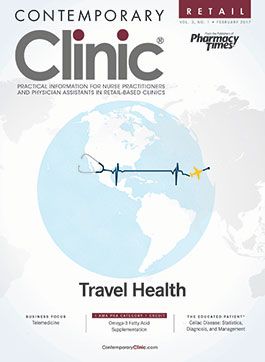Telemedicine: An Added “Convenience†for Patients in Convenient Care Clinics
Convenient care clinics (CCCs) provide a cost-effective alternative when primary care providers are unable to accommodate a patient with a last-minute appointment or provide treatment for an acute illness.
Convenient care clinics (CCCs) provide a cost-effective alternative when primary care providers are unable to accommodate a patient with a last-minute appointment or provide treatment for an acute illness. CCCs offer access to patients who need nonemergency care after hours or on weekends or holidays.1They have saved patients an estimated $135.53 million by providing an alternative to the emergency department, urgent care, and primary care providers.2Shorter wait times compared with primary care offices further incentivize patients to seek care at CCCs, while increasing patient satisfaction.3
Telemedicine
A component of telehealth, telemedicine is a type of electronic communication that exchanges medical information between 2 geographical locations via technology such as videoconferencing, the Internet, or telephone.
Telehealth also encompasses remote patient monitoring, population health management, and mobile health technologies.
This allows individuals to receive care from both rural locations nationally and remote locations internationally. Miami Children’s Hospital recently developed telemedicine models that can treat patients in pediatric subspecialties internationally in Ecuador, the Cayman Islands, and the Vatican.
45
Growth and Cost Reduction
Telemedicine has grown substantially since its beginnings. With an annual growth of 20% per year, it is estimated that there will be 7 million visits achieved by the year 2018.
Telemedicine alone has reduced health care costs while providing quality, convenient care. The University of Pittsburgh Medical Center found that their “Anywhere Care,” which provides primary and urgent care via telemedicine, has saved $86.64 per telepatient visit versus an onsite visit. Oregon Health and Science University has offered telemedicine for 8 years, allowing 45% of patients to stay in their home communities and save $6.4 million in transportation costs while receiving care that is usually unavailable in small community hospitals.4
Ensuring that standards of care and patient safety are maintained is imperative when incorporating telemedicine into practice and considering its future growth. Professional associations and organizations have made recommendations and guidelines regarding telemedicine to ensure that quality, safe care is delivered while protecting the provider—patient relationship. With guidelines of practice in place, telemedicine has the potential for further growth.
Reimbursement
Reimbursement cost proves to be a challenge when integrating telemedicine into practice. Medicare payment for telemedicine is limited to Part B services, technologies, and areas. In addition, specific rules govern telehealth so that telemedicine must be used in locations outside metropolitan statistical areas or in a rural area that has a shortage of health care professionals; thus the provider is limited to practice setting. Medicaid allows for reimbursement for telemedicine in the form of interactive or live video, and there is ongoing legislation to increase Medicaid reimbursement for these services. Private insurance has begun partnerships with telemedicine companies in the hopes of decreasing costs and improving patient satisfaction.
6
State reimbursements and licensure requirements affect the feasibility of adopting telemedicine into practice.7Policies that promote private payer reimbursement for telehealth can encourage telemedicine adoption, whereas federal reimbursements, including those for Medicare, have historically been a barrier to expansion.8
Telemedicine Operations and Patient Flow
Launching telemedicine within the CCC involves equipment such as laptops or tablets, electronic medical records, digital diagnostic tools, point-of-care testing supplies, cameras, blood pressure cuffs, and Internet access. Clinical telemedicine assistants are specially trained to use the equipment and collect data such as history and physical examination, vital signs, and other information pertinent to the patient visit as per established protocols. Once they record this information, the provider can review it, discuss the chief complaint, and determine a diagnosis and treatment plan with the patient.9Prescriptions and aftercare instructions can then be e-mailed to the patient for review.
Conclusion
Telemedicine, a subpart of telehealth, plays an integral role in providing convenient care to those who are not able to see their provider due to geographic location or time of need. With videoconferencing technology, clinics can interact with patients, both locally and abroad, to provide comprehensive patient-centered care without the need for travel.
By using telemedicine in the convenient care setting, clinicians can play a pivotal role in improving health care access that is both affordable and feasible. As technology advances, telemedicine will become an essential part of the services offered to patients to increase satisfaction in delivery of care.
is a nurse practitioner at MinuteClinic and an associate clinical assistant professor at National University.
Katarzyna Lalicata, MSN, FNP-C, FNP-BC,
References
- Evans SW. Convenient care clinics: making a positive change in Health care.J Am Acad Nurse Pract.2010;22(1):23-26. doi:10.1111/ j.1745-7599.2009.00466.x.
- Patwardhan A, Davis J, Murphy P, Ryan SF. After-hours access of convenient care clinics and cost savings associated with avoidance of higher-cost sites of care.J Prim Care Community Health.2012;3(4):243-245. doi:10.1177/2150131911436251.
- Patwardhan A, Davis J, Murphy P, Ryan SF. Comparison of waiting and consultation times in convenient care clinics and physician offices: a cross-sectional study.J Prim Care Community Health.2013;4(2):124-128. doi: 10.1177/2150131912450030.
- Cronin T. Implementing a stroke program using Telemedicine.J Emerg Nurs. 2013;39(6):613-618. doi: 10.1016/j.jen.2012.04.012.
- Henderson K, Davis TC, Smith M, King M. Nurse practitioners in telehealth: bridging the gaps in health care delivery.Journal Nurse Pract.2014;10(10):845-850. doi:10.1016/j.nurpra.2014.09.003.
- Daniel H, Sulmasy LS; Health and Public Policy Committee of the American College of Physicians. Policy recommendations to guide the use of telemedicine in primary care settings: an American College of Physicians position paper.Ann Intern Med. 2015;163(10):787-789. doi: 10.7326/M15-0498.
- Adler-Milstein J, Kvedar J, Bates DW. Telehealth among US hospitals: several factors, including state reimbursement and licensure policies, influence, adoption.Health Aff (Millwood). 2014;33(2):207-215. doi: 10.1377/hlthaff.2013.1054.
- Brannon JA, Brown J. Telepractice reimbursement on the rise.The ASHA Leader. 2012;17:3-22. doi:10.1044/leader.BML1.17122012.3. American Speech-Language-Hearing website. leader.pubs.asha.org/article.aspx?articleid=2280614. Accessed October 11, 2016.
- Markwick L, McConnochie K, Wood N. Expanding telemedicine to include primary care for the urban adult.J Health Care Poor Underserved. 2015;26(3):771-776. doi: 10.1353/hpu.2015.0078.

